Intel Architecture Day 2021: Alder Lake, Golden Cove, and Gracemont Detailed
by Dr. Ian Cutress & Andrei Frumusanu on August 19, 2021 9:00 AM ESTGracemont Microarchitecture (E-Core) Examined
The smaller core as part of Intel’s hybrid Alder Lake design is called an E-core, and is built on the Gracemont microarchitecture. It forms part of Intel’s Atom family of processors, and is a significant microarchitectural jump over the previous Atom core design called Tremont.
- 2008: Bonnell
- 2011: Saltwell
- 2013: Silvermont
- 2015: Airmont
- 2016: Goldmont
- 2017: Goldmont Plus
- 2020: Tremont
- 2021: Gracemont
Based on Intel’s diagrams, the company is pitching that the size of its Golden Cove core means that in the space it would normally fit one of its P-core designs, it can enable a four core cluster of E-cores along with a shared 4MB L2 cache between them.
For performance, Intel has some pretty wild claims. It splits them up into single thread and multi-thread comparisons using SPECrate2017_int.
When comparing 1C1T of Gracemont against 1C1T of Skylake, Intel’s numbers suggest:
- +40% performance at iso-power (using a middling frequency)
- 40% less power* at iso-performance (peak Skylake performance)
*'<40%' is now stood to mean 'below 40 power'
When comparing 4C4T of Gracemont against 2C4T of Skylake, Intel’s numbers suggest:
- +80% performance peak vs peak
- 80% less power at iso performance)peak Skylake performance
We pushed the two Intel slides together to show how they presented this data.
By these graphics it looks like that for peak single thread, we should see around +8% better than Skylake performance while consuming just over half the power – look for Cinebench R20 scores for one Gracemont thread around 478 then (Skylake 6700K scored 443). With +8% for single thread in mind, the +80% in MT comparing 4 cores of Gracemont to two fully loaded Skylake cores seems a little low – we’ve got double the physical cores with Gracemont compared to Skylake here. But there’s likely some additional performance regression with the cache structure on the new Atom core, which we’ll get to later on this page.
These claims are substantial. Intel hasn’t compared the new Atom core generation on generation, because it felt that having AVX2 support would put the new Atom at a significant advantage. But what Intel is saying with these graphs is that we should expect better-than Skylake performance at much less power. We saw Skylake processors up to 28 cores in HEDT – it makes me wonder if Intel might not enable its new Atom core for that market. If that’s the case, where is our 64-core Atom version for HEDT? I’ll take one.
Front End
The big item about the Tremont front end of the core was the move to dual three-wide decode paths, enabling two concurrent streams of decode that could support 3 per cycle. That still remains in Gracemont, but is backed by a double-size 64 KB L1 Instruction cache. This ties into the branch predictor which enables prefetchers at all cache levels, along with a 5000-entry branch target cache which Intel says in improved over the previous generation.
Back on the decoder, Intel supports on-demand decode which stores a history of previous decodes in the instruction cache and if recent misses are recalled at the decode stage, the on-demand stream will pull directly from the instruction cache instead, saving time – if the prefetch/decode works, the content in the instruction cache is updated, however if it is doing poorly then the scope is ‘re-enabled for general fetches’ to get a better understanding of the instruction flow. This almost sounds like a micro-op cache without having a physical cache, but is more to do about instruction streaming. Either way, the decoders can push up to six uops into the second half of the front end.
For Gracemont, the reorder buffer size has increased from 208 in Tremont to 256, which is important aspect given that Gracemont now has a total of 17 (!) execution ports, compared to eight in Tremont. This is also significantly wider than the execution capabilities of Golden Cove's 12 ports, related to the disaggregated integer and FP/vector pipeline design. However, despite that width, the allocation stage feeding into the reservation stations can only process five instructions per cycle. On the return path, each core can retire eight instructions per cycle.
Back End
So it’s a bit insane to have 17 execution ports here. There are a lot of repeated units as well, which means that Gracemont is expecting to see repeated instruction use and requires the parallelism to do more per cycle and then perhaps sit idle waiting for the next instructions to come down the pipe. Overall we have
- 4 Integer ALUs (ALU/Shift), two of which can do MUL/DIV
- 4 Address Generator Units, 2 Load + 2 Store
- 2 Branch Ports
- 2 Extra Integer Store ports
- 2 Floating Point/Vector store ports
- 3 Floating Point/Vector ALUs: 3x ALUs, 2x AES/FMUL/FADD, 1x SHA/IMUL/FDIV
It will be interesting to see exactly how many of these can be accessed simultaneously. In previous core designs a lot of this functionality would be enabled though the same port – even Alder Lake’s P-core only has 12 execution ports, with some ports doing double duty on Vector and Integer workloads. In the P-core there is a single scheduler for both types of workloads, whereas in the E-core there are two separate schedulers, which is more akin to what we see on non-x86 core designs. It’s a tradeoff in complexity and ease-of-use.
The back-end is support by a 32 KiB L1-Data cache, which supports a 3-cycle pointer chasing latency and 64 outstanding cache misses. There are two load and two store ports, which means 2x16 byte loads and 2 x 16 byte stores to the L1-D.
There is also has a shared 4 MB L2 cache across all four E-cores in a cluster with 17-cycle latency. The shared L2 cache can support 64 bytes per cycle read/write per core, which Intel states is sufficient for all four cores. The new L2 supports up to 64 outstanding misses to the deeper memory subsystem – which seems fair, but has to be shared amongst the 4 cores.
Intel states that it has a Resource Director that will arbitrate cache accesses between the four cores in a cluster to ensure fairness, confirming that Intel are building these E-cores in for multi-threaded performance rather than latency sensitive scenarios where one thread might have priority.
Other Highlights
As the first Atom core to have AVX2 enabled, there are two vector ports that support FMUL and FADD (port 20 and port 21), which means that we should expect peak performance compared to previous Atoms to be substantial. The addition of VNNI-INT8 over the AVX unit means that Intel wants these E-cores to enable situations where high inference throughput is needed, such as perhaps video analysis.
Intel was keen to point out that Gracemont has all of its latest security features including Control Flow Enhancement Technology (CET), and virtualization redirects under its VT-rp feature.
Overall, Intel stated that the E-cores are tuned for voltage more than anything else (such as performance, area). This means that the E-cores are set to use a lot less power, which may help in mobile scenarios. But as mentioned before on the first page, it will depend on how much power the ring has to consume in that environment - it should be worth noting that each four core Atom cluster only has a single stop on the full ring in Alder Lake, which Intel says should not cause congestion but it is a possibility – if each core is fully loaded, there is only 512 KB of L2 cache per core before making the jump to main memory, which indicates that in a fully loaded scenario, that might be a bottleneck.


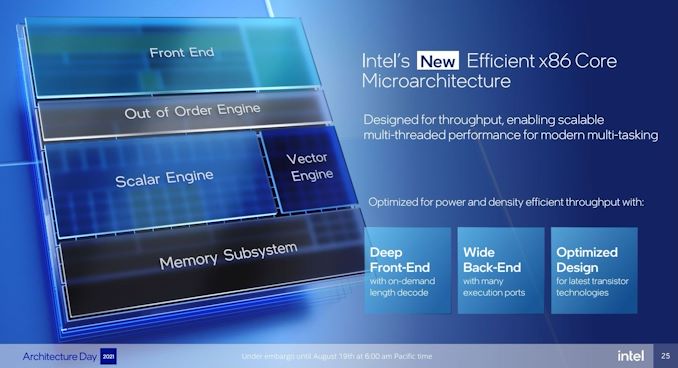
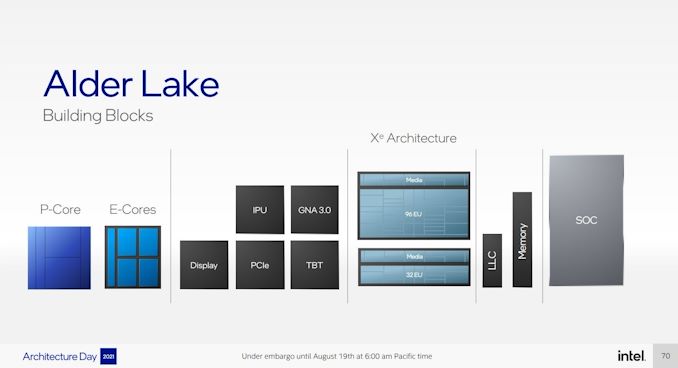

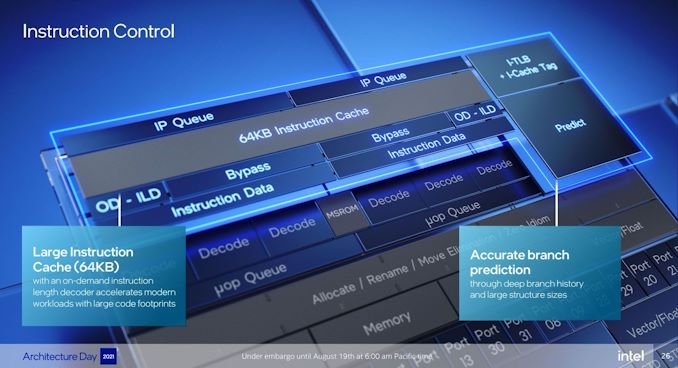
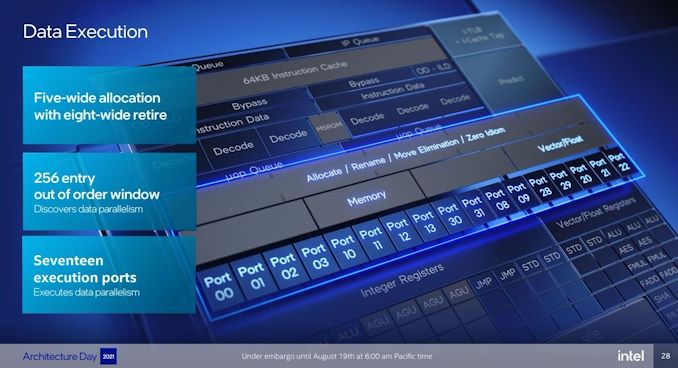
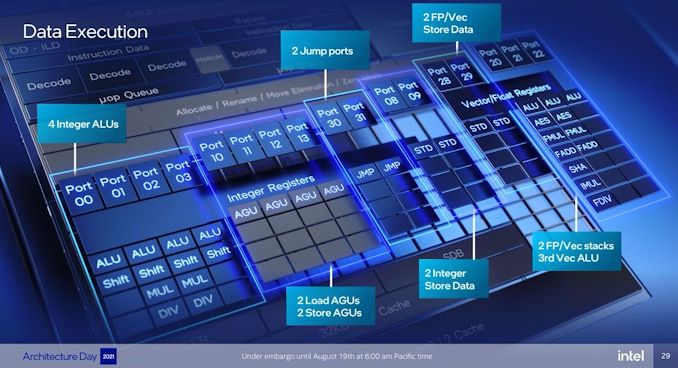









223 Comments
View All Comments
mode_13h - Friday, August 20, 2021 - link
> - treat all-zero lines as special cases that are tagged in L2/SLC but don't require> transferring data on the NoC. Intel had something like this in IceLake that, after
> some time, they switched off with microcode update.
I heard about that. Sad to see it go, but certainly one of those micro-optimizations that's barely measurable.
name99 - Thursday, August 19, 2021 - link
" This is over double that of AMD’s Zen3 µarch, and really only second to Apple’s core microarchitecture which we’ve measured in at around 630 instructions. "Apple's ROB is in fact around 2300 entries in size. But because it is put together differently than the traditional ROB, you will get very different numbers depending on exactly what you test.
The essential points are
(a)
- the ROB proper consists of about 330 "rows" where each row holds 7 instructions.
- one of these instructions can be a "failable", ie something that can force a flush. In other words branches or load/stores
- so if you simply count NOPs, you'll get a count of ~2300 entries. Anything else will hit earlier limits.
(b) The most important of these limits, for most purposes, is the History File which tracks changes in the logical to physical register mapping. THIS entity has ~630 entries and is what you will bump into first if you test somewhat varied code.
Earlier limits are ~380 int physical registers, ~420 or so FP registers, ~128 flag registers. But if you balance code across fp and int you will hit the 630 History File limit first.
(c) If you carefully balance that against code that does not touch the History File (mainly stores and branches) than you can get to almost but not quite 1000 ROB entries.
The primary reason Apple looks so different from x86 is that (this is a common pattern throughout Apple's design)
- what has traditionally been one object (eg a ROB that tracks instruction retirement AND tracks register mappings) is split into two objects each handling a single task.
The ROB handles in-order retiring, including flush. The History File handles register mapping (in case of flush and revert to an earlier state) and marking registers as free after retire.
This design style is everywhere. Another, very different, example, is the traditional Load part of the Load/Store queue is split into two parts, one tracking overlap with pending/unresolved stores, the second part tracking whether Replay might be required (eg because of missing in TLB or in the L1).
- even a single object is split into multiple what Apple calls "slices", but essentially a way to share rare cases with common cases, so the ROB needs to track some extra state for "failable" instructions that may cause a flush, but not every instruction needs that state. So you get this structure where you have up to six "lightweight" instructions with small ROB slots, and a "heavyweight" instruction with a larger ROB slot. Again with see this sort of thing everywhere, eg in the structures that hold branches waiting to retire which are carefully laid out to cover lots of branches, but with less storage for various special cases (taken branches need to preserve the history/path vectors, none-taken branches don't; indirect branches need to store a target, etc etc)
GeoffreyA - Friday, August 20, 2021 - link
Thanks for all the brilliant comments on CPU design!mode_13h - Friday, August 20, 2021 - link
Go go go!GeoffreyA - Thursday, August 19, 2021 - link
I think Intel did a great job at last. Golden Cove, impressive. But the real star's going to be Gracemont. Atom's come of age at last. Better than Skylake, while using less power, means it's somewhere in the region of Zen 2. Got a feeling it'll become Intel's chief design in the future, the competitor to Zen.As for Intel Thread Director, interesting and impressive; but the closer tying of hardware and scheduler, not too sure about that. Name reminded me of the G-Man, strangely enough. AVX512, good riddance. And Intel Marketing, good job on the slides. They look quite nice. All in all, glad to see Intel's on the right track. Keep it up. And thanks for the coverage, Ian and Andrei.
Silver5urfer - Friday, August 20, 2021 - link
Lol. That is no star. The small puny SKL cores are not going to render your high FPS nor the Zip compression. They are admitting themselves these are efficiency. Why ? Because 10SF is busted in power consumption and Intel cannot really make any more big cores on their Desktop platform without getting power throttled. On top their Ring bus cannot scale like SKL anymore.GeoffreyA - Friday, August 20, 2021 - link
Not as it stands, but mark my words, the Atom design is going to end up the main branch, on the heels of Zen in p/w. Interesting ideas are getting poured into this thing, whereas the bigger cores, they're just making it wider for the most part.ifThenError - Friday, August 20, 2021 - link
Totally understand your point and I'd personally welcome such a development!Anyway, the past years have shown a rather opposite way. Just take ARM as an example. There once was an efficiency line of cores that got the last update years ago with the A35. Now it's labelled as "super efficient" and hardly has any implementations aside from devices sitting idle most of the time. You can practically consider it abandoned.
The former mid tier with the A55 is now marketed as efficient cores, while the former top tier A7x more and more turns into the new midrange. Meanwhile people go all crazy about the new X1 top tier processors even though the growth of power consumption and heat is disproportionate to the performance. Does this sound reasonable in a power and heat constraint environment? Yeah, I don't think so either! ;-)
For that reason I perfectly understand Ian's demand for a 64 core Gracemont CPU. Heck, even a 16 core would still be #1 on my wishlist.
GeoffreyA - Saturday, August 21, 2021 - link
Yes, performance/watt is the way to go, and I reckon a couple more rounds of iteration will get Atom running at the competition's level. The designs are similar enough. It's ironic, because Atom had a reputation for being so slow.mode_13h - Saturday, August 21, 2021 - link
> Atom had a reputation for being so slow.With Tremont, Intel really upped their Atom game. It added a lot of complexity and grew significantly wider.
However, it's not until Gracemont's addition of AVX/AVX2 that Intel is clearly indicating it wants these cores to be taken seriously.
I wonder if Intel will promote their Atom line of SoCs as the new replacement for Xeon D. Currently, I think they're just being marketed for embedded servers and 5G Basestations, but they seem to have the nous to taken the markets Xeon D was targeting.